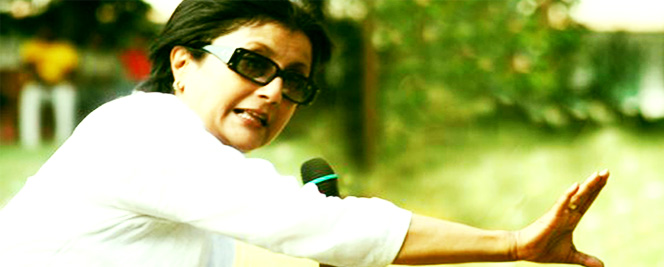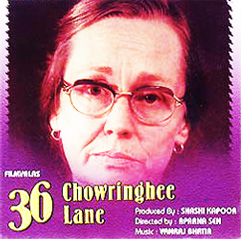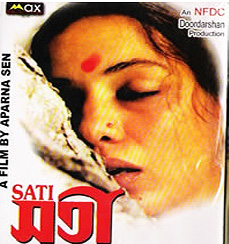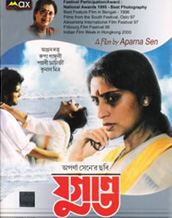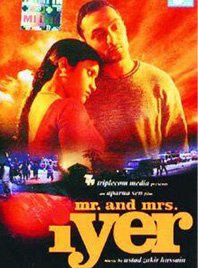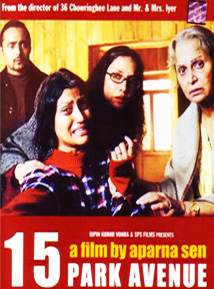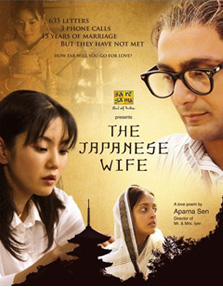Aparna Sen, is one of India’s few women directors, who has managed to carve a niche for herself. Born in 1945, Aparna began her film career as an actress in the film ‘Sampatti’ by Satyajit Ray at an early age of 16.
However, after two decades of successful career as a film actress, she slowly turned towards direction, driven by the pure passion of filmmaking. She was very closely associated with the Ray in many other ways. Like maestro, Aparna Sen also shows in all her films a final victory of the good and a restoration of basic values of life.
Aparna has made selective films and in the last 28 years, she has made only eight films.
In 1981, Sen made her debut as a film director with 36 Chowringhee Lane. She also wrote its screenplay. The film, about an aged Anglo-Indian teacher living in Calcutta, won positive reviews from critics. For her debut feature, Sen won the Best Director award at the Indian National Film Awards. It also won the Grand Prix (the Golden Eagle) at the Manila International Film Festival.
She followed up this early success with several other films, notably Paroma (1984), Sati (1989) and Yuganta (1995), Paromitar Ek Din (2000), Mr. and Mrs. Iyer (2002), 15, Park Avenue (2005), The Japanese Wife ( released in 2010) and her next Bengali/Hindi film Iti Mrinalini, which is ready for release.
Women in Aparna Sen’s Films
All along, Aparna Sen’s eight feature films I see two different currents.
The first, mostly evident in her films until YUGANTA, is a skeptical view on contemporary India.
Her characters are lonely, sometimes very isolated women trapped by their belonging to a special ethnic group like the old Anglo-Indian lady Violet Stoneham in 36 CHOWRINGHEE LANE or caught in their tradition like the middle class woman in PAROMA or the deaf girl in SATI, an outsider in a village in India in the 19th century who is discriminated by an orthodox Hindu community.
In one of her later films, 15 PARK AVENUE Aparna Sen returns to her tragic, almost desperate women. This time, a young woman is isolated by her disease. Their loneliness is like a gravitation field they hardly can escape.
In her grimiest film YUGANTA the female protagonist is even an artist, an intellectual but yet she has to struggle as well in a patriarchal system. Remarkable is that in YUGANT, the failure of a couple in their relationship is interwoven with the failure of modern civilization. Hints to the first Gulf war and ecological disasters lead this film consequently to one of the most apocalyptical endings I have ever seen in Indian cinema.
YUGANTA changes permanently between past and present of a couple who meets again after years at the places of their honeymoon while PAROMITAR EK DIN (House of Memories) begins with the death of the mother in law and enfolds in flashbacks the story of the film.
That introduces as well another current in her work. Beside her critical and sometimes grim view at a male-dominated Bengali society and especially at the situation of women or ethnic minorities, her female characters begin to fight for their happiness with all the strength they have. That includes slight ideas of happiness as fragile they might be.
On another level, Aparna Sen’s work might be seen in the context of the decline of Bengali Parallel cinema in the 90s after the death of Satyajit Ray. It was caused by the stricter commercialization of Indian film industry but also of the fact that since the 80s, with some great filmmakers, the southern state Kerala replaced the dominance of Bengali cinema as the leading region for Indian Parallel cinema. Even though Aparna Sen made very few films, she became one of the leading personalities in Bengali art house cinema.
Then came MR. AND MRS. IYER, one of the finest Road Movies for decades. It established Aparna Sen as one of the finest storytellers in Indian cinema. It can be appreciated just as a well told story or as a parable of diversities and tensions in the multicultural society of the Indian sub continent. It is a about a friendship between a married orthodox Hindu woman and a Muslim during a long travel by bus and train to Kolkata disturbed by communal riots between Muslims and Hindus.
It is also one of Aparna Sen’s richest films, not to mention the brilliant photography by filmmaker Gautam Ghose or the soulful performances by Sen’s daughter Konkona Sen Sharma and Rahul Bose, an actor whose appearances in Sen’s films marks a special chapter in her work.
MR. AND MRS. IYER is also Aparna Sen’s first film with moments of humor and also a human kaleidoscope of several different characters. The diversity in India is evident in several spoken languages and even if they switch to English, we hear different accents.
Between India as a human landscape of diversity, the geological landscape plays also an important role. There are images and reflections of contemporary India, but there is also a mythical landscape how it can only created in cinema.
In this traveling through landscapes with several different people, I feel reminded in John Ford or in the old Japanese masters like Yasujiro Ozu or Hiroshi Shimizu (who also made one of the finest Road Movies with Arigato-San Mr. THANK YOU, 1936).
Road Movies may have a kind of natural affinity to cinema itself. The views from the bus or train, limited through framed windows have to do with the limited frame of the cinematic images on the screen. Most of the protagonists are though fictional characters but as well close to the situation of the audience of a film. The film has a balance between action and contemplation. A typical moment in this film is the irony that Meenakshi, the Hindu-woman and Raja have to pretend they are a married couple (for protecting the muslim Raja against Hindu extremists). It is part of the story but also we see Konkona Sen Sharma and Rahul Bose performing as a fictive couple.
As an individual Meenakshi is not very different from Aparna Sen’s lonely and mostly unhappy women and she will probably trapped in her orthodox tradition until the rest of her life. But for moments, Aparna Sen allows her to dream of a romance and a more self-determined life. Even though this romance never worked out, it is an option or at least a vision of change.
In her most experimental film 15 PARK AVENUE, Aparna Sen again deals with a classical subject in cinema, the loss of reality, the small line between dream and reality or the question what is reality and how we perceive it. Again with Konkona Sen Sharma and Rahul Bose, the main plot deals with the story of a schizophrenic young woman called Mitali (Sen Sharma). It is once a portrait of a woman isolated -this time not by society but by her disease – on the other way, it is as well a film which could be seen in the film historic context from early German fantastic cinema, Hitchcock, David Lynchs MULHOLLAND DRIVE or even to Scorseses latest film SHUTTER ISLAND.
Mitalis story is told from different angles, her parents, her eldest sister and her former boyfriend who cancelled years ago their planned marriage. A psychiatrist tries to analyses what he learns about her by her family. They all do their best to get a comprehension of Mitali. But they finally fail.
15 PARK AVENUE is interwoven with surreal moments after the approach of a rational understanding fails. And the moment, we think we got a track to Mitalis story- the film turns into a subtle but surreal final which evokes in me the end of Antonioni’s BLOW UP.
15 PARK AVENUE and YUGANT are two of her most disturbing films; and her unusual use of the montage of images and sounds pushes us to ask after every scene- our orientation in this mysterious film where the thin line between reality and dream finally disappears.
Her latest release THE JAPANESE WIFE seems to me her finest work. It takes place in the incredible landscape of the Sunderbans and tells the love story of the village teacher Snehamoy and the Japanese woman Miyage. Their relationship is only lived through letters, exchanges of gifts and a few phone calls. They even marry by letter. It is again a story enfolded by a cinematic richness typical for Aparna Sen’s later films.
And here again, we have a perfect balance between the things we see and the things we have to imagine. Nature in the form of this moody river, landscape or the weather plays an important role. This time literally a whole group of widows and orphans make an effort to form a family-like community. All of them have no real family, but they make an effort to form a life as social beings.
The film is also with a lot of humor and Rahul Bose offers one of his finest performances in a role between tragedy and comedy. It is also like MR. and MRS. IYER, a film with an Ozu-like justice for her characters which evokes at least for moments a world without hierarchies.
On another level THE JAPANESE WIFE is also a virtuous piece of cinema in its almost musical structure with several repeated motives. This film moves so smoothly from one sequence to the next that it seems to be “made by itself” (how German film-critic and teacher Helmut Färber once described Ozus LATE SPRING, 1949 and Jean Renoirs THE RIVER, 1951).
How Aparna Sen varies the motive of Snehamoys long distant calls to Miyage from very funny moments to an explicit heartbreaking scene can be compared with Ozu’s use of music-like motives in his last film AN AUTUMN AFTERNOON.
In 30 years, Aparna Sen defined her own answers for the eternal question: what is cinema?
Aparna Sen never followed any fashions or trends in cinema nor did she answer stereotypical expectations as a female filmmaker.
From her sensitive observations of desperate women she developed images of the human condition. And finally she is a great visual storyteller who reminds us that cinema is the art of seeing.

